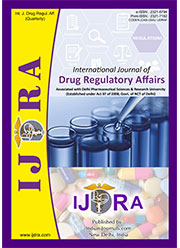FDA's drug regulatory pathways, its development strategies and regulatory considerations
Abstract
People who are interested in drug development may be aware that New Drug Applications (NDA) and Abbreviated New Drug Applications (ANDA) are 2 of the FDA's regulatory pathways for how prescription drugs can be approved and ultimately reach the market. In basic terms, NDAs are for new drugs that have not yet been approved and ANDAs are for generic products.
NDA, also called 505 (b)(1), is the format that manufacturers use to bring a formal proposal to the FDA that a new drug should be approved and made available for use by patients in the United States. Under 505(b)(1), all investigations supporting safety and effectiveness, both clinical and nonclinical, are conducted by or on behalf of the sponsor. The other pathway is termed as abbreviated because preclinical and clinical trials are not required. The abbreviated approval pathways are described in section 505(j) and 505(b)(2) of the FD&C Act and known as ANDA and Hybrid applications respectively. Hatch-Waxman amendments in 1984 provided for a suitability petition that allows the application of ANDA for a drug product that differs from the RLD in its dosage form, route of administration, strength, or active ingredient (in a product with more than one active ingredient). The differences allowed for suitability petition and 505(b)(2) application are same but ANDA filed through suitability petition can contain only those differences that do not need clinical evidence for efficacy and safety. This article identifies considerations to help potential applicants determine the appropriate submission pathway, its development strategies to support approval under those pathways.
Downloads
References
2. USFDA. Guidance for Industry: Determining Whether to Submit an ANDA or a 505(b)(2) Application, Draft Guidance; 2017 Oct.
3. Danielle Moffett Nuventra’s Pharmascience Blog [Internet]. Durham, NC: Danielle Moffett; 2020 Feb 05 [cited 2021 Feb 05]. Available from: https://www.nuventra.com/resources/blog/quick-guide-to-fda-drug-application-types/
4. Brandon Burch Nuventra’s Pharmascience Blog. IND requirements exemptions [Internet]. Durham, NC: Brandon Burch; 2018 Jun 20 [cited 2021 Feb 05]. Available from: https://www.nuventra.com/resources/blog/ind-requirements-exemptions/
5. 505 (b)(2) Regulatory Pathway for New Drug Approvals, November 1, 2017 by Ryan Chandanais, MS, CPhT [Internet]. Pharmacytimes; 2017 Nov 01 [cited 2021 Feb 07]. Available from: https://www.pharmacytimes.com/view/505-b2-regulatory-pathway-for-new-drug-approvals-
6. USFDA. Guidance for Industry: Applications Covered by Section 505(b)(2), Draft Guidance; 1999 Oct.
7. Michael J. Lamson Nuventra’s Pharmascience Blog. What is 505b2 [Internet]. Durham, NC: Michael J. Lamson; 2021 Mar 10 [cited 2021 Feb 09]. Available from: https://www.nuventra.com/resources/blog/what-is-505b2/
8. USFDA. ANDA [Internet]. US: Food & Drug Administration; 2019 May 22 [cited 2021 Feb 09] Available from: https://www.fda.gov/drugs/types-applications/abbreviated-new-drug-application-anda
9. Brandon Burch Nuventra’s Pharmascience Blog [Internet]. Durham, NC: Brandon Burch; 2018 Jan 10 [cited 2021 Feb 06]. Available from: https://www.nuventra.com/resources/blog/bioequivalence-studies-support-generic-drugs/
10. Manual of Policies And Procedures, Office Of Generic Drugs, ANDA Suitability Petitions: MAPP 5240.5 Rev. 2
11. Brandon Burch Nuventra’s Pharmascience Blog. Types of marketing exclusivity [Internet]. Durham, NC: Brandon Burch; 2019 Aug 28 [cited 2021 Feb 07] Available from: https://www.nuventra.com/resources/blog/types-of-marketing-exclusivity/
12. M SK, Katamreddy JD, P JR. A review on ANDA submission requirements for Generic drugs: “Paragraph IV certification” as per FDA CDER guidelines. Int J Drug Reg Affairs [Internet]. 2018 Sep15 [cited 2021 Jun 15]; 6(3):5-12. Available from: http://ijdra.com/index.php/journal/article/view/260
13. Shah S, Badjatya JK. Preliminary requirement for filing application in US. Int J Drug Reg Affairs [Internet]. 2018 Dec 20 [cited 2021 Jun 15];6(4):1-8. Available from: http://ijdra.com/index.php/journal/article/view/276

This work is licensed under a Creative Commons Attribution-NonCommercial 4.0 International License.
The International Journal of Drug Regulatory affairs require a formal written transfer of copyright from the author(s) for each article published. We therefore ask you to complete and return this form, retaining a copy for your records. Your cooperation is essential and appreciated. Any delay will result in a delay in publication.
I/we have read and agree with the terms and conditions stated Page 2 of this agreement and I/we hereby confirm the transfer of all copyrights in and relating to the above-named manuscript, in all forms and media, now or hereafter known, to the International Journal of Drug Regulatory affairs, effective from the date stated below. I/we acknowledge that the IJDRA is relying on this agreement in publishing the above-named manuscript. However, this agreement will be null and void if the manuscript is not published in the IJDRA.
Download link for COPYRIGHT FORM







